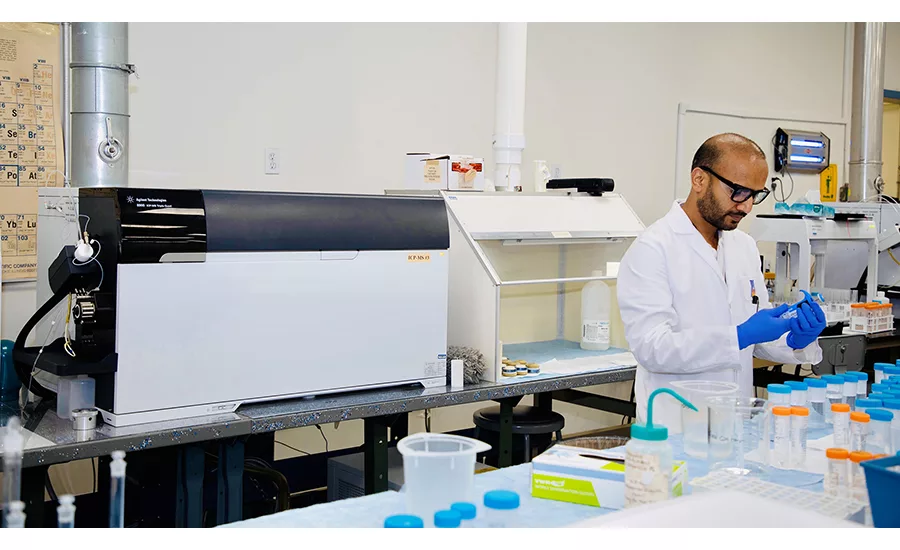Elevating TOC Testing to Top of To-Do List
Companies need to establish that their water system is adequately designed, controlled, maintained and monitored to ensure that it is consistently producing water for its intended use.

TOC is the total amount of carbon bound in an organic compound and is used as a non-specific indicator of water quality or cleanliness in product manufacturing processes. Image courtesy of NJ Labs
A flood of warning letters from the FDA on water system suitability could pull the plug on the production of food, beverage, cosmetic, nutraceutical and over-the-counter (OTC) or pharmaceutical products if companies are not conducting total organic carbon (TOC) water testing analysis on a regular basis.
Some FDA warning letters that have been issued call out companies that have failed to validate that their water systems consistently produced water suitable for its intended use. Companies need to establish that their water system is adequately designed, controlled, maintained and monitored to ensure that it is consistently producing water for its intended use. Those who fail to correct their water system can face regulatory or legal action, including seizures or an injunction. Unresolved violations may also prevent other federal agencies from awarding contracts. The FDA can also withhold the issuance of export certificates or the approval of new applications.
Do I have your attention on the importance of conducting TOC water testing on a regular basis? Let’s dive into the details on how it is done.
The 411 on TOC Water Testing
TOC water testing analysis is frequently used as a technique for determining water purity. Once tested, the level of organic carbon in the water determines the level of impurities. Different industries must adhere to different standards for acceptable water purity in final goods and water utilized in manufacturing.
During the manufacturing process, the element most essential is water. Traditionally, TOC water testing has had a long history of being used as a method to measure water quality during the drinking water purification process. For example, increasing levels of the amount of natural organic matter (NOM) has been shown to increase the levels of carcinogens in processed drinking water, which TOC water testing detects. Beyond drinking water, the quality of the water used in manufacturing will dramatically affect the quality of pharmaceutical, nutraceutical or cosmetics products produced. Therefore, TOC is the total amount of carbon bound in an organic compound and is used as a non-specific indicator of water quality or cleanliness in product manufacturing processes.
Additionally, the USP (United States Pharmacopeia), the EP (European Pharmacopeia) and JP (Japanese Pharmacopeia) all recognize TOC analysis as a required test for purified water as well as for WFI (water for injection). The USP states:
“TOC is an indirect measure of organic molecules present in pharmaceutical waters measured as carbon. Organic molecules are introduced into the water from the source water from purification and distribution system materials, and from biofilm growing in the system. TOC can also be used as a control attribute to monitor the performance of unit operations comprising the purification and distribution system.”
At NJ Labs, customers will also ask us to perform TOC testing to measure low total carbon content, which measures organic molecules or contaminants, or for cleaning validations.
Sampling and Performance
There are several methods of oxidizing samples that can be used depending upon the nature and concentration of TOC being measured, analytical requirements and the instruments being used for the TOC analysis, including:
- High temperature combustion measured by non-dispersive infrared absorption (NDIR);
- High temperature catalytic oxidation with a platinum catalyst, followed by NDIR;
- Thermo-chemical oxidation;
- Photo-chemical oxidation with ultraviolet (UV) and chemical oxidizers; and
- Photo-oxidation using UV light or a catalyst.
Studies have shown that the photo-oxidation method via UV light is the most reliable and accurate method for performing TOC tests and determining TOC levels. Our experience at NJ Labs confirms this method as well. You can see exactly how TOC testing is performed in this tutorial video created by our lab technicians.
Analyzing TOC Analyzer
TOC analyzers measure the amount of organic, inorganic or total carbon in water samples. This works by oxidizing the organic compound into a form that can be quantified. Oxidizing organic carbon produces carbon dioxide (CO2), which can then be measured and converted into a TOC value or measurement. There are multiple TOC analyzers that labs will use to measure water quality. At NJ Labs, TOC analyses are done using the state-of-the-art Fusion Analyzer from Teledyne Tekmar. This modern laboratory instrument is designed to determine the carbon content in water and other materials. It uses a UV oxidation reactor, which is a relatively new technology that allows a degree of sensitivity previously unattainable. TOC water testing analysis is essential in the pharmaceutical industry for inspection of ultrapure water and evaluation of cleaning effectiveness. It has found wide acceptance in the biotechnology industry to assist in cleaning validation procedures, especially for Clean-In-Place (CIP) procedures.
Real-Time Decision Making
Testing organic load variations in real-time provides manufacturers with a data-driven, decision-making tool for quality control, process monitoring and regulatory compliance. TOC water testing analysis is a simple method to measure water quality and provide insights into all organics present—from ingredient to production to wastewater processes. If leaks or impurities are detected, quick adjustments can be made to help prevent contamination, thereby minimizing the risk that the product does not meet quality specifications, which would otherwise require manufacturers to dump the product and take a financial loss. Undetected leaks can lead to brand-damaging product recalls. By ensuring the water is the quality it should be, TOC water testing assists in maintaining the integrity of manufacturers’ products.
Looking for a reprint of this article?
From high-res PDFs to custom plaques, order your copy today!






